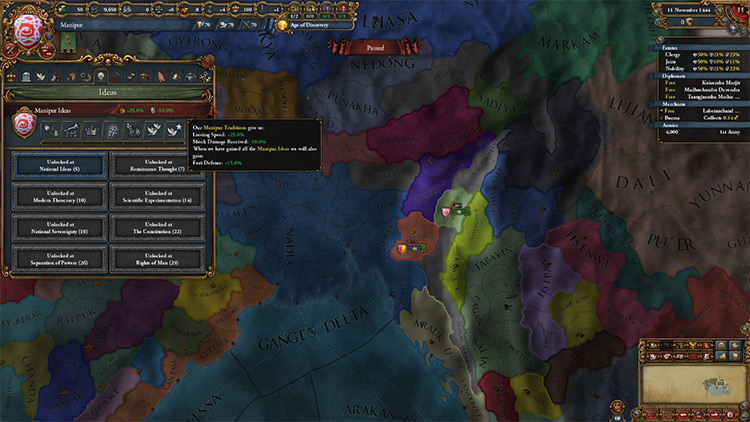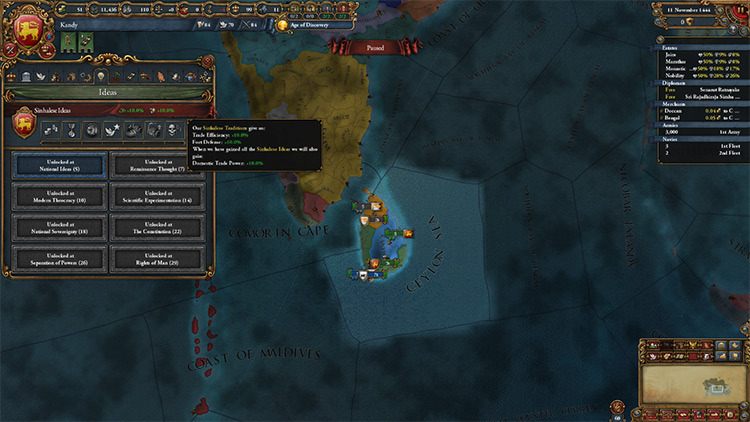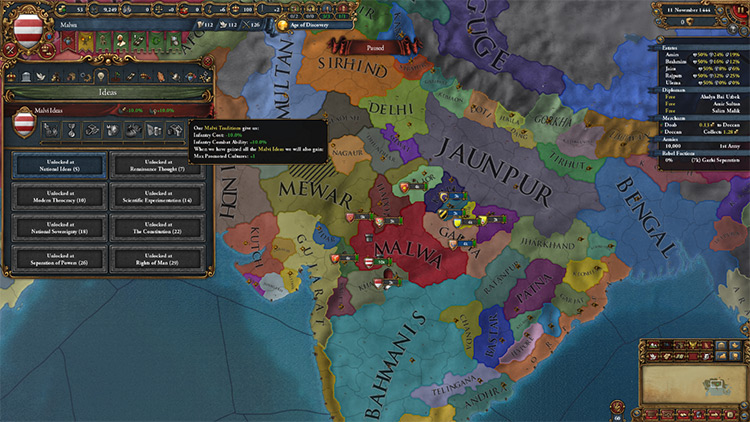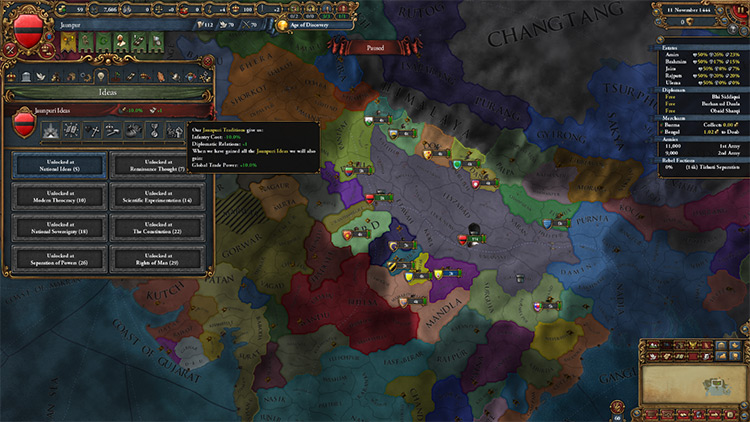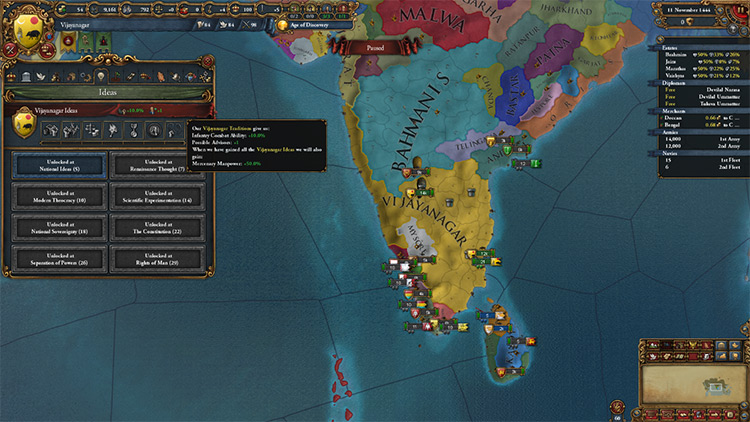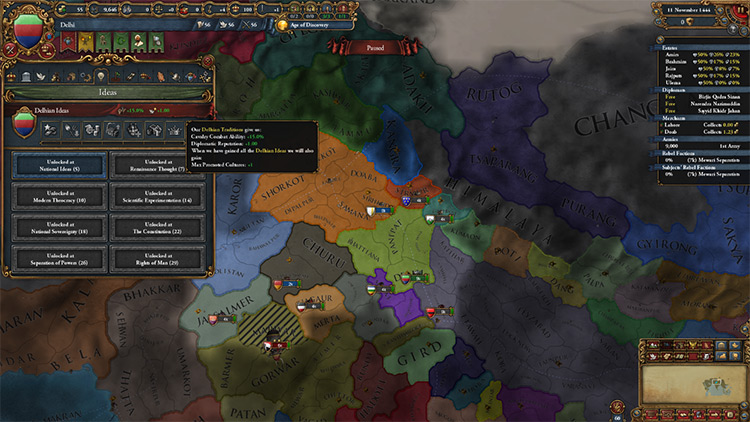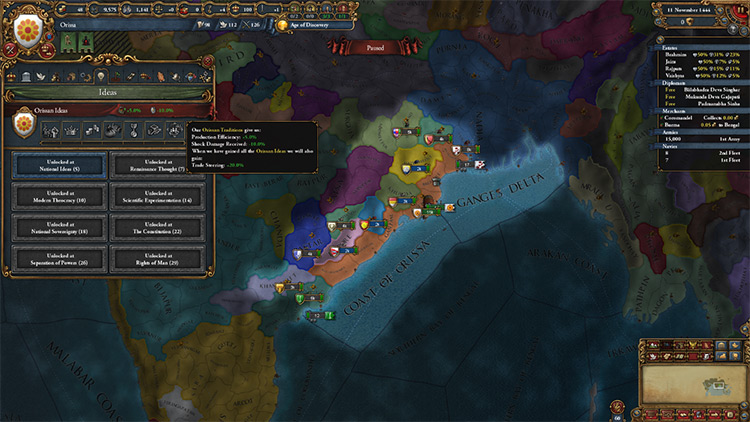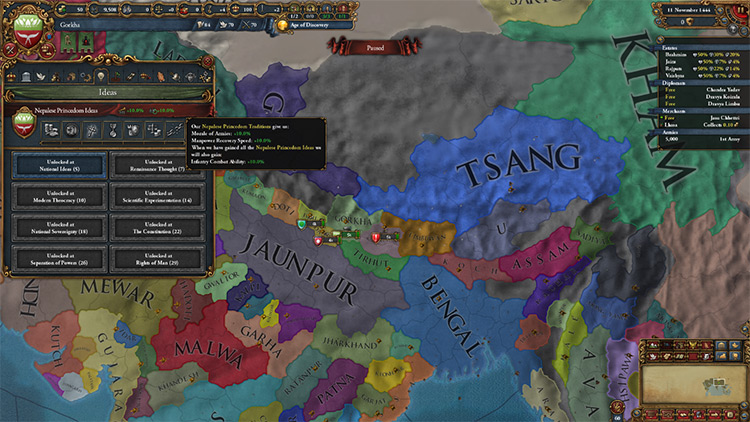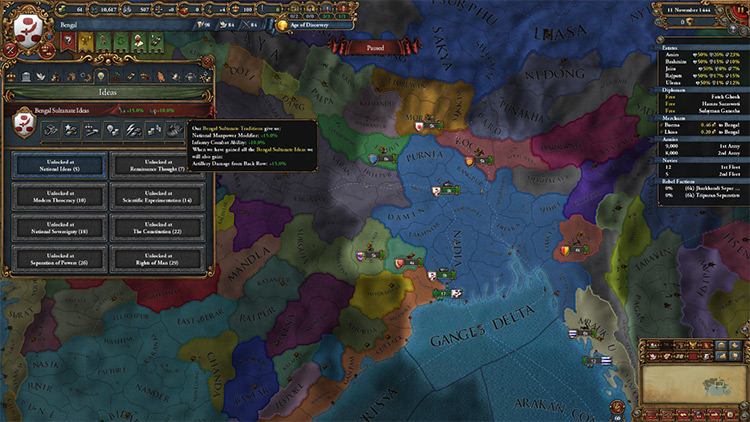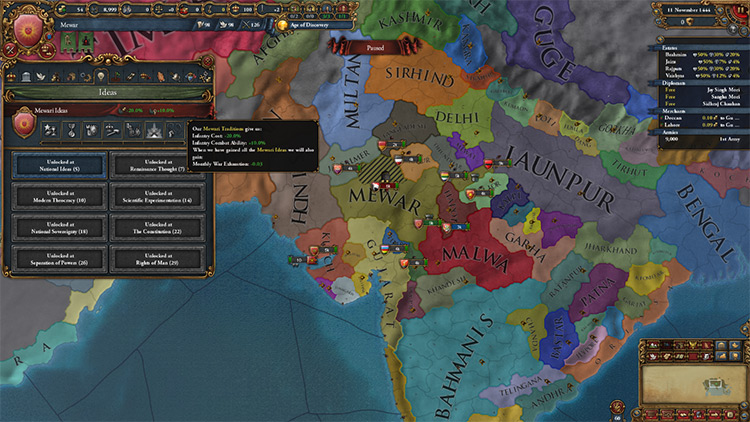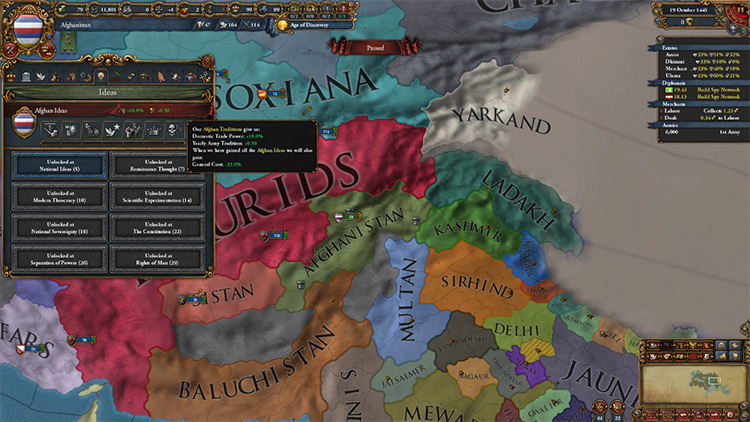India is demarcated by the Himalayan range to the north, the Hindu Kush to the west, and the Arakanese mountains to the east. The Indian Ocean and the Arabian Sea to the continent’s southeast and southwest respectively grant the region natural protection against outside forces. The only frequent invaders that make an appearance are Timurid princes forming the Mughals – but that’s a part of the Indian experience! India offers a grand variety of nations, with different idea sets and mission trees. There’s something that fits every kind of player. Some of my very favorite nations and achievements have their home in India. From the Himalayas to the north, all the way to the isle of Ceylon, let’s see who the most fun & interesting nations in the Indian subcontinent are!
12. Manipur
Manipur starts the game as a single province nation amidst the Naga Hills, at the border between India and Burma. It’s unique because it’s the only animist nation in India. Manipur also has a unique achievement that you can grab “The Animal Kingdom”, which has you conquering the Bengal region and converting it to animism. Not the easiest achievement for sure. Manipur isn’t a nation I would recommend to beginners. You need to act fast and decisively against your neighbors. Keep an eye out and be opportunistic against the Bengali Sultanate. Alliances will not be easy to form due to your religion.
11. Kandy
Kandy is another small and hard nation like Manipur. Located in Ceylon, your only route of expansion will be through the Vijayanagar empire to your north. First, you need to break free and annex your overlord because you begin as a vassal. Kandy has little in the way of flavor, lacking a mission tree and unique events. Its national ideas are nothing exceptional. Kandy and its overlord, Kotte, are the only Buddhist nations in India. They share a unique achievement “The Buddhists Strike Back”, which requires conquering all of India as one of them and converting it to Buddhism. Kandy has another achievement, “Cotton Kandy”, which needs you to become the leading producer of cotton. And with two unique achievements, Kandy is a campaign all achievement hunters are bound to do at some point.
10. Malwa
Malwa makes the cut for this list mostly due to its great starting situation. Your Sunni faith allows you to easily ally with major powers, depending on the starting alliances and rivalries. Your central position lets you decide what path of expansion you wish to follow. While weaker than many nearby nations, Malwa makes up for it with its flexible diplomatic situation in the early game. The nation has little flavor and no unique mission tree but enjoys strong starting national traditions. This means that eventually forming a nation like Delhi, Rajputana, or Marathas will be a priority of yours. Although having no unique achievements makes this less of an appealing choice.
9. Jaunpur
Jaunpur is essentially a bigger and stronger Malwa. Controlling the heartland of the rich Gangeatic plane, Jaunpur’s riches are coveted by all its neighbors. This is the greatest threat for the nation. Your neighbors will probably hate you. However, being one of the preeminent forces in India, you can leverage your strength to find allies in more distant lands. The Jaunpuri national ideas aren’t half bad, and scale well into the late game. Consider keeping them even if you form another nation. Usually, you want to form Delhi for the mission tree. Helping Sirhind usurp Delhi can give you a temporary ally while you deliver a killing blow on your southern rival of Bengal. After that, turn north against your former friend and form Delhi yourself!
8. Vijayanagar
Vijayanagar is probably the strongest nation in India at the game’s start. It’s my recommended nation to all beginners wishing to get familiar with the dynamics of the Indian subcontinent. I mean, Vijayanagar has the whole package: Flavorful event chains, a mission tree, decent ideas, and a lot of starting land. Plus the unique achievement it shares with its northern rival Bahmanis is the cherry on top. Your rival, the Bahmanid Sultanate to the north, is the main obstacle you will have to face early. Conflict with them is inevitable. Do not underestimate their arm. They’re slightly stronger in the field of battle early on due to their Shia religion! Your mission tree will lead you down a path of overseas expansion, making the Indian Ocean your personal lake.
7. Delhi
Delhi is the nation you want to form as soon as possible when playing as the flavorless Sultanates around it. However, Delhi itself begins the game and you can choose the nation from the beginning. Delhi’s situation isn’t the easiest one, either. With a stronger and highly disloyal vassal and only 4 provinces under your direct control, rebellion is inevitable. Sirhind is scripted to rebel through event as early as 1445. You can prevent that by putting a ruler of your dynasty on their throne. A Delhi campaign will be a challenge early on. You start will a lot of cores on your vassal and Jaunpur to the south, but consolidating that land won’t be easy. After an initial victory over Jaunpur, the campaign becomes significantly more relaxed. Your reward for restoring the Sultanate to its former glory is a unique achievement, “Emperor of Hindustan”.
6. Orissa
Orissa is a personal favorite of mine. You begin the game sandwiched between stronger powers in every direction, with some room to expand in the Central Indian jungles. You start as the suzerain of four other nations, with your mission tree encouraging you to vassalize more, eventually consolidating them under a single vassal. Your mission tree in general is extensive, focusing on dominance of the Indian Ocean. You’ll start with an excellent ruler and good national traditions, as well as a small military buff from your first mission. This gives you the tools necessary to punch above your weight against your neighbors. Bengal can be handled in a fair one on one. On the southern front you will have to be opportunistic. Exploit the inevitable war between Bahmanis and Vijayanagar and strike them while they are weakened. Orissa’s unique achievement “Foremost Servitor of Jaganath” is one of the hardest in the game. It requires controlling all provinces that produce tropical wood in the entire world. Prepare for a long campaign if you want the achievement!
5. Gujarat
The Sultanate of Gujarat is one of the richest nations at the game’s start. Your diplomatic situation is a bit rocky, as you find yourself flanked by rivals on all sides. Allying the other Muslim sultanates in northern India will be easy, however. Gujarat has trade focused national ideas, a unique and flavorful mission tree, and a strong powerbase. The mission tree is one of my favorite ones. It isn’t the typical conquer X, get claims on Y, conquer Y, and so on and so forth. It focuses on the Western India region and the Gujarat trade node, encouraging development of your core lands. And this mission tree culminates in the creation of a trade empire across the Arabian sea. That said, the lack of a unique achievement is a pity, as it makes Gujarat less appealing to aspiring achievement hunters.
4. Gorkha/Nepal
The Gorkha princedom at first glance doesn’t have anything particularly interesting. No unique events or mission tree, and a national idea set that’s mediocre at best. So why does it make this list? Well, Gorkha has a unique achievement “The Pheasant Strut”, which wants you to form Nepal and defeat Prussia in a war with at least 100 thousand casualties on the Prussian side. Yes, a very specific achievement indeed. The formable nation of Nepal is the reason Gorkha makes our list. Of course, any nation with Nepali or Pahari culture can form Nepal. You can always culture convert and form it as anyone! Nepal has a national idea set that is comparable to Prussia’s. All but one idea in it are military bonuses. If you want to play as a military powerhouse in India, Nepal is the nation you want to form. It’s one of the formable nations you will always see in competitive multiplayer campaigns.
3. Bengal
The Bengali Sultanate begins the game in what is probably the safest position in India. Especially when controlled by a player. It’s not uncommon to see Bengal becoming a major power even under AI hands. Bengal has an interesting mix of a mission tree and national ideas. The Sultanate is given many tools that enable tall gameplay, while also enjoying a lot of claims in northern India and Burma. It has something for you regardless of what gameplay you enjoy the most. And there’s a unique achievement that wants you to conquer Samarkand, which offers a nice goal to aim for. Although it can be cheesed early on by conquering through Tibet, if you want an easy way to grab it. Bengal focuses on trade and the development of its core lands, while still offering a lot of expansion options. You’ll never find yourself bored in such a campaign.
2. Bahmanis
The Bahmani Sultanate lies at the heart of the Deccan plateau and the entirety of India. As a Muslim state, it differs from every other one in India as they follow the Shi’a school of Islam. The Bahmanis enjoy decent flavor in the form of events, an extensive and unique mission tree, as well as a very strong power base. While its national ideas are lackluster, they complement their playstyle quite nicely. The mission tree is the highlight of the nation. It will lead you towards the conquest of southern India and Gujarat at first. Nothing different from other mission trees in the area. Various missions encourage developing your lands and interacting with the Marathas estate. This mission tree eventually leads you across the sea, into Persia and Mesopotamia. It finishes off with strong permanent modifiers when you finish your conquest of Persia’s major cities. After that, unifying India or forming Persia can offer you more content to enjoy, while significantly powering up your nation. Remember: Persia’s national ideas are some of the strongest in the game!
1. Mewar
Mewar, Mewar never changes. That’s actually the name of one of the achievements you can unlock by playing as the nation of Mewar. Situated at the heartland of Rajputana, Mewar is the preeminent power among the proud Rajput princedoms. As the only strong Hindu nation in the north, you are beset by religious enemies on all sides. Mewar has an awesome national idea set – one that’s up there with the likes of Nepal in terms of military power. Their mission tree sends you down the path of revenge… revenge against the Muslim invaders who usurped the Rajput empires of old and now dominate northern India. But it’s one of the most detailed and well-made mission trees in the game. You get an achievement for completing it entirely. Fortify ancient forts and reclaim lost lands. Restore great cities to their former glories and serve as the Indian vanguard against any and all aspiring invaders! Mewar offers a moderately challenging campaign with a lot of rewarding moments, and a military that can steamroll all opposition with the unique Rajput regiments you get access to.
Bonus: Afghanistan/Timurid Princes
While not inside India, it feels mandatory to mention the Timurid princes that are encouraged to move into the subcontinent and form the Mughal empire. Well, the Timurids are also eligible for that, but playing as them feels like cheating to be honest. Afghanistan is chosen to represent the whole group due to its proximity to India. Conquering Delhi and forming the Mughal Empire gives you access to tons of flavor in the form of events, a gigantic and detailed mission tree, insane national ideas, and a powerful unique government type. The Mughals are up there with the strongest nations in the entire game, and they couldn’t be missing from this article. Their powerful mission tree eventually gives them +10% administrative efficiency (among other things), while their unique government automatically accepts fully controlled cultures. The cherry on top is the unique achievement the vassal Timurid states have access to: “True Heir of Timur”. It’s probably the most infamous achievement in the game – it requires you conquer all of India by 1550. This achievement serves as a ribbon to distinguish yourself as a veteran of the game.
